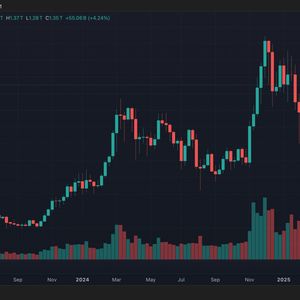Postgres Revolution: How ParadeDB Unleashes Unprecedented Data Search Amidst the AI Applications Boom
5 min read
BitcoinWorld Postgres Revolution: How ParadeDB Unleashes Unprecedented Data Search Amidst the AI Applications Boom In the fast-paced world of technology, where artificial intelligence is reshaping industries and demanding unprecedented data capabilities, the underlying infrastructure often determines success. For those deeply invested in the crypto space, understanding robust data solutions is key to navigating volatile markets and complex analytics. This is where an unexpected hero emerges: Postgres , an open-source database management system nearly four decades old, is experiencing an explosive resurgence, driven by its surprising suitability for modern AI Applications . But as demand surges, a critical challenge remains: efficient data search and analytics. Enter ParadeDB, a groundbreaking solution poised to transform how we interact with vast datasets, directly challenging established players like Elasticsearch. Why is Postgres Becoming the Database of Choice for AI Applications ? For decades, Postgres has been a reliable workhorse in the database world, known for its stability, extensibility, and adherence to SQL standards. Its open-source nature fosters a vibrant community and continuous innovation. However, its recent surge in popularity is directly tied to the burgeoning field of artificial intelligence. AI models thrive on structured, reliable data, and Postgres offers a robust foundation for managing this information. Its ability to handle complex queries, support various data types, and integrate with a wide array of tools makes it an ideal backend for many AI-driven systems. As Bitcoin World has reported, industry giants are recognizing this trend, with significant acquisitions like Crunchy Data by Snowflake and Neon by Databricks underscoring Postgres’s strategic importance in the evolving data landscape. How is ParadeDB Revolutionizing Data Search and Analytics? Despite Postgres ‘s undeniable strengths, a significant gap has persisted: native, high-performance full-text search and analytics capabilities. Traditionally, organizations would resort to moving their valuable data to separate systems, such as Elasticsearch, to perform these critical functions. This introduces complexity, latency, and increased costs. ParadeDB is changing this paradigm entirely. As an innovative open-source extension, ParadeDB allows users to perform sophisticated Data Search and analytics directly within their existing Postgres databases. This eliminates the need for cumbersome data transfers, ensuring that data remains secure, consistent, and immediately accessible. ParadeDB seamlessly integrates with popular cloud Postgres offerings like Google Cloud SQL, Azure Postgres, and Amazon RDS, making it accessible to a wide range of enterprises. The Elasticsearch Challenge: Why a New Approach to Data Management Was Needed? For years, Elasticsearch has been the go-to solution for full-text search and analytics, especially for large datasets. Founded in 2012, it built its reputation on powerful search capabilities. However, its fundamental architecture often involves moving data back and forth between a primary database like Postgres and Elasticsearch itself. Philippe Noël, co-founder and CEO of ParadeDB, highlights the inherent issues with this approach. “That breaks all the time,” Noël told Bitcoin World. “The two databases are not meant to work together. There’s a lot of compatibility issues, there’s a lot of latency issues, higher costs, and all of that deteriorates the user experience.” This constant data synchronization can be a nightmare for heavy workloads or applications requiring real-time updates. ParadeDB’s core innovation lies in addressing these pain points by building directly into Postgres, offering a more integrated and efficient solution for comprehensive Data Management . Riding the AI Applications Boom: ParadeDB’s Growth and Future Vision ParadeDB’s journey began in 2023, with its founders, Philippe Noël and Ming Ying, driven by their own frustrations with Postgres search limitations during their first startup, Whist. Recognizing a widespread problem, they focused on developing a robust open-source product first. This strategy quickly paid off. In early 2024, Chinese e-commerce giant Alibaba became ParadeDB’s first enterprise customer, a testament to the platform’s immediate value. This pivotal moment propelled ParadeDB into building out its enterprise software, attracting other prominent clients like Modern Treasury, Bilt Rewards, and TCDI. The company recently secured a significant $12 million Series A funding round, led by Craft Ventures with participation from existing investors including Y Combinator. These funds are earmarked for strategic hiring, expanding their current team of four to at least ten employees, and enhancing the platform’s user interface and analytics capabilities. This rapid growth trajectory underscores the immense demand for better Data Search solutions in the age of advanced AI Applications . Seamless Data Management : Real-World Impact and Integration ParadeDB’s approach to Data Management is rooted in simplicity and efficiency. By functioning as a native extension, it eliminates the operational overhead associated with managing separate search infrastructures. This direct integration means developers can leverage their existing Postgres knowledge and tools, streamlining workflows and reducing development time. The success stories from early adopters like Alibaba, Modern Treasury, Bilt Rewards, and TCDI highlight the tangible benefits: improved performance, reduced costs, and a more unified data experience. As Devin Pratt, a research director at IDC, noted to Bitcoin World, the industry is increasingly consolidating around Postgres, with major acquisitions validating its central role. ParadeDB is strategically positioned to capitalize on this trend, offering a compelling alternative to traditional, separate search solutions. “We think building on Postgres is actually a meaningful shift,’” Noël concluded. “Because that’s where the data is, and you can make a meaningful dent in Elasticsearch ’s market share by meeting users where their data is, rather than building something that’s marginally faster or marginally cheaper.” In conclusion, ParadeDB represents a significant leap forward in database technology, particularly for organizations grappling with the demands of modern AI Applications . By empowering Postgres with native, high-performance Data Search and analytics, it offers a powerful, integrated, and cost-effective solution that challenges the status quo established by legacy systems like Elasticsearch . As the world becomes increasingly data-driven, ParadeDB’s innovative approach to Data Management positions it as a key player in the next generation of enterprise infrastructure. To learn more about the latest AI applications trends, explore our article on key developments shaping AI models features. This post Postgres Revolution: How ParadeDB Unleashes Unprecedented Data Search Amidst the AI Applications Boom first appeared on BitcoinWorld and is written by Editorial Team

Source: Bitcoin World



